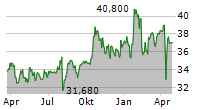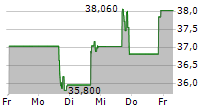
Just 5% of board directors are under the age of 50. But research indicates that more age-diverse boards may possess unique business advantages.
NORTHAMPTON, MA / ACCESSWIRE / October 22, 2024 / AllianceBernstein

Bob Herr | Director of Corporate Governance
Luke Pryor | Portfolio Manager-Security of the Future; Co-Portfolio Manager-Responsible US Equities; Senior Research Analyst-US Large Cap Value
A company's governance practices can provide valuable insights into its risk management and sustainability-and a company's board composition is a key factor to consider. Research-our own included-indicates that the age diversity of a company's board of directors may correlate with operational performance and shareholder returns, making a strong case for multigenerational boards.
Long on Experience, Short on Age Variability
There's a lot to be said for experience. Directors need the right mix of skills and experience to provide effective guidance and oversight. That often comes with time. But there's a point at which boards may become too monolithic, in our view.
Consider, for example, that nearly 70% of directors within S&P 500 companies represent a single generation-baby boomers. Moreover, only 5% of directors are under the age of 50.
Why does that matter? A broader range of generational perspectives on corporate boards may improve operating performance, strengthen business durability and smooth succession planning.
Those aren't just theories. They're backed up by research.
Age Diversity Linked to Improved Oversight and Financials
Researchers from the University of New Hampshire found that the presence of directors from Generation X (people born between 1965 and 1980) was correlated with improved financial performance, as measured by return on assets and price to book. Notably, the study found that that relationship was especially strong at firms that invest more in research and development (R&D) and engage in patenting activity.
Another recent study focused on more than 7,000 banks. Controlling for various firm and board characteristics, researchers found that greater age diversity on bank boards was correlated with higher-quality earnings reporting, reduced loan charge-offs and fewer nonperforming loans. The authors theorize that multigenerational boards are more likely to challenge entrenched managerial decisions and established protocol, resulting in improved monitoring effectiveness.
Eventually, of course, businesses need a succession plan for their leaders. Here, too, multigenerational boards appear to provide benefits. According to PwC, increased age diversity among corporate board members allows for more gradual leadership changes-reducing loss of experience and knowledge and smoothing inevitable leadership transitions. The study also suggested that multigenerational boards may help expand the pool of future leaders, while increasing teamwork and collaboration within an organization.
So, what does this mean for investors? Quite a bit, it turns out.
The Link Between Multigenerational Boards and Share Prices
We sorted constituents of the Russell 1000 Index into three baskets according to the age range of their directors. The first basket comprised boards with a greater than 30-year difference between the oldest and youngest directors. On the other end of the spectrum were boards with small age variability-20 years or less. A third basket made up the middle, with boards spanning 21 to 30 years in age difference.
After analyzing stock performance from 2017 through 2023, we found that companies with the greatest board age variance produced the strongest annualized returns, while those with the least age variance produced the weakest returns.
This trend was consistent across most sectors but was more pronounced in innovation-oriented sectors-even when controlling for founder-led versus non-founder-led organizations. Board age diversity appeared to be most valuable in R&D-intensive sectors like technology and healthcare, and least valuable in less R&D-intensive sectors like materials and real estate (Display).
Board Age Considerations Warrant a Closer Look
This isn't to say that youth trumps experience, nor are we suggesting that companies nominate inexperienced younger directors or entrenched older directors to maximize a board's age range. In our view, a director's qualifications are still of paramount importance. Nonetheless, multigenerational boards have tended to deliver stronger investment performance than their monogenerational counterparts over the past several years.
Despite a growing body of evidence highlighting the benefits of age diversity on corporate boards, we've yet to see any regulation or governance codes that address this issue. That could eventually change. Over time, we hope to better understand whether companies are including age diversity in their board refreshment considerations, and to identify sectors in which this may be most (and least) relevant.
There are many factors to consider when investing; the makeup of a company's board is just one. But given the correlation between board age diversity and improved operating metrics and returns, we believe age diversity on corporate boards warrants a closer look.
Landon Shea, Investment Stewardship Associate, and Michael Crovetto, Research Analyst, were instrumental in the research supporting this blog.
The views expressed herein do not constitute research, investment advice or trade recommendations and do not necessarily represent the views of all AB portfolio-management teams. Views are subject to change over time.
Learn more about AB's approach to responsibility here.
View additional multimedia and more ESG storytelling from AllianceBernstein on 3blmedia.com.
Contact Info:
Spokesperson: AllianceBernstein
Website: https://www.3blmedia.com/profiles/alliancebernstein
Email: info@3blmedia.com
SOURCE: AllianceBernstein
View the original press release on accesswire.com




